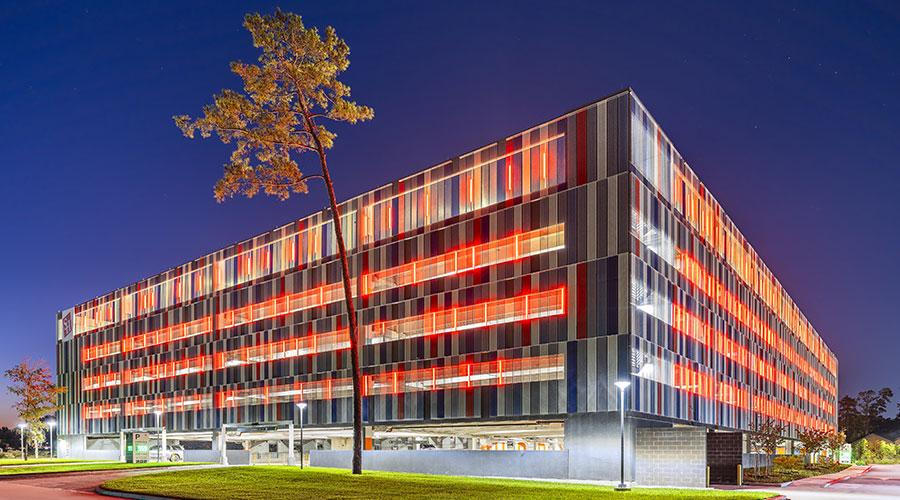 Lighting control applications need to take into account the needs of the space in question, such as an open office.
Lighting control applications need to take into account the needs of the space in question, such as an open office.Lighting Controls Upgrade Guidelines
Focusing on control strategies, space needs and planning principles can help managers create successful installations
Lighting controls can reduce lighting energy costs by up to 35 percent while offering maintenance and engineering managers additional capabilities for tuning light levels and brightness, controlling color, and generating data they can leverage for new operational efficiencies. But achieving real value in a given upgrade requires the proper specification and application of controls.
In new buildings where energy codes regulate design, controls typically must be installed to control nearly all lighting. In an existing building undergoing an upgrade from traditional sources to LEDs, controls can be installed as part of the upgrade wherever sufficient opportunity and value intersect. That value can be sweetened by utility rebates when applicable.
To deliver successful lighting controls upgrades, managers need to focus on several key issues — understanding control strategies, determining space needs, and applying planning principles.
Focus on strategies
Lighting controls and systems are essentially input/output boxes. The input might be based on occupancy, a time event on a schedule, a light level or a signal from another building system. The output is typically switching — on or off — or dimming — raise or lower light level — though demand for new capabilities such as color output control and data generation is growing significantly.
The combinations of these inputs and outputs give managers a range of available control strategies that are driven by the primary application need, which can be energy management, visual needs, or operational efficiency.
For energy management, managers need to consider four main strategies, all based on the principle that lighting should be turned off or reduced when occupants do not need it:
• Occupancy sensing can automatically switch or dim lighting and switch plug loads when a space is unoccupied and potentially send a signal to a security system.
• Scheduling can automatically switch or dim lighting and switch plug loads based on occupancy predicted at certain times.
• Daylight response entails automatic switching or dimming lighting when daylight raises light levels.
• Institutional task tuning involves tailoring light levels by individual space.
For visual needs, the two main strategies are:
• Manual-control switching or dimming based on human intervention.
• Color tuning involves the manual or automatic adjustment of color output, either by tuning white light on a scale between warm — orangish to white — and cool — bluish-white — or by producing saturated colors for a communication or entertainment purpose.
For operational efficiency, managers can produce data and monitor a lighting system for failures, and they can use this automatically generated information to analyze energy use, monitor equipment for maintenance, track inventory, and identify efficiencies in space utilization, among other uses.
Outputs are driven by what managers want the controls to do. For visual needs and information, the application is driven primarily by these goals because the inputs do not depend on the application, only the outputs.
For example, if a manager wants to enact space-optimization strategies based on measuring occupancy patterns, then a data-delivering control system is optimal. If a manager wants the lighting system to change the color quality of white light in a classroom to allow teachers to signal a change in activity, then color tuning is optimal. And if a manager wants users to be able to adjust light level for presentations in a conference room, some type of dimming solution is optimal.
For strategies dictated by energy management, the controls application is driven by conditions that enable various inputs. If the space is intermittently occupied, managers can consider occupancy sensing. If the space is predictably occupied, they can consider scheduling. If the project is designed at a fixed light level significantly higher than that needed in individual spaces, consider institutional task tuning. And if the space has ample daylight, daylight response is a viable option.
Looking at the outputs of switching or dimming, the most appropriate choice depends on the way occupants use the space:
Occupancy sensing and scheduling. If the space is unoccupied and lights are not needed for safety or security, switching is optimal. But if the space is unoccupied and the lights must stay on — such as in a lobby, corridor, or stairwell — dimming is optimal.
Institutional task tuning. Generally, the output is dimming because the space is used while this strategy is in effect.
Daylight response. The control effect might occur while the space is occupied. If occupants are performing demanding, stationary tasks, then dimming is optimal. For transitional spaces such as lobbies, managers can implement switching with less likelihood of disrupting occupants.
Related Topics:














